So, you launched your coaching business and are wondering, “How do I get coaching clients?”
It’s a valid question, and the best part is that it has many answers. Since I became a business mentor in 2015 I have helped countless coaches, leaders, and entrepreneurs grow their lists, incomes, and businesses.
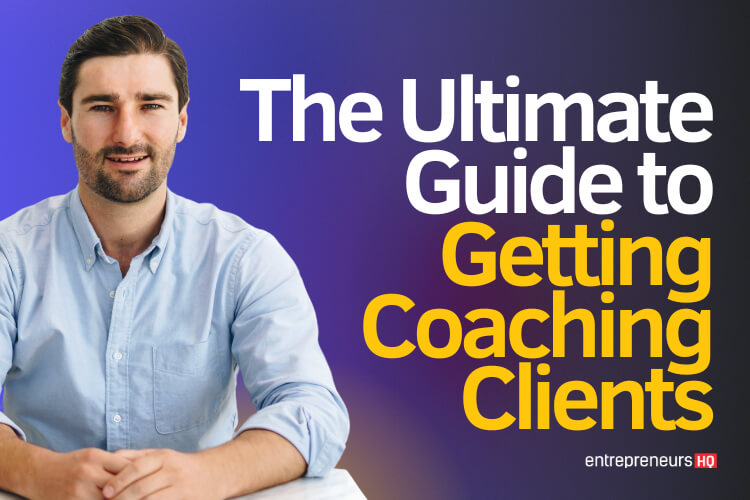
Moreover, I have designed dozens of offers for my courses and coaching programs, added over 100,000 leads to my email list and booked more than 3,000 appointments on my sales calendar.
As a result, I speak from experience when I say that all you need is the right strategy to start landing coaching clients. In this post, I’ll share how to get coaching clients with a step-by-step plan and real examples.
Table of Contents
Building Your Marketing Foundation for Your Coaching Business
Attracting and maintaining a client base comes down to one word: marketing.
How well you can capture attention, build relationships, and add value to the lives of others will determine your roster of potential coaching clients. All of these factors contribute to your success. So, the question then becomes: What do you have to do to build your marketing foundation so your online coaching business can thrive?
Here are a few simple steps you can take today to start building momentum.
Identify your coaching niche
What segment of the market will you serve?
This is probably the most essential step regarding organic marketing strategies as it positions you as an authority in your space. Clients want to do business with experts who specialize in solving the exact problem they’re struggling with. Niche down, and you become a big fish in a small pond.
Generalist coaches who can “help with anything” don’t have the authority or specialized knowledge to be effective at anything.
As a result, they fail to pull the higher rates that coaches who specialize can command.
Specialization is the key to online marketing. A good example of this concept in action is Erin Power, a certified health and wellness coach with 30 years of experience in the health and fitness industry.

She specializes in fat loss and metabolic flexibility and helps her clients form healthy relationships with food and their bodies. Notice she doesn’t just specialize in “health and fitness”…
She helps people specifically with fat loss and metabolic flexibility. She has a specialization within a specialization. Niching down in this way sets you apart and positions you as an expert in your field. And that’s what makes a potential customer part of your ideal audience.
Align your marketing and niche with your strengths
Your niches and marketing efforts should align with your natural strengths.
For example, Abe Brown is a life coach based in Canada. He is the CEO of a successful life coaching certification company that helps entrepreneurs, thought leaders and influencers build their brands and establish their authority. His personal experience is what makes his coaching process so effective.
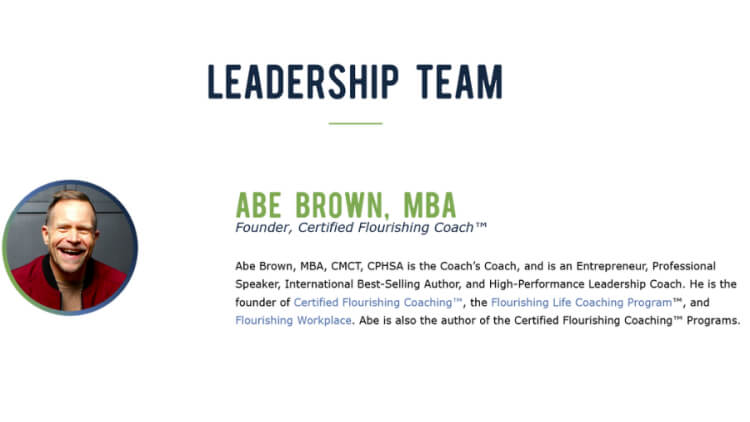
He’s always been an entrepreneur.
As a result, Abe has gone through the same struggles as his audience. His entrepreneurial journey has given him valuable insights into his target market’s psychology. So, his marketing efforts consist of him pulling from his own experiences to create empathy with his audience and draw them into his brand (and eventually funnel).
His business is thriving as a result.
If you want to know how to get coaching clients, start by determining what your strengths are and how you can use them to the advantage of others. To do this, take an inventory of yourself by asking the following questions:
- What have I overcome in my life that I can now help others with?
- What experiences or skill sets do I have that others need?
- What unique knowledge or interests separate me from other coaches?
- How can I market my expertise to my ideal client in a way that meets their needs?
- How can my stock of knowledge impact the lives of my target demographic?
- How can my unique strengths solve the problems my market is facing?
Analyze market demand
If there’s no demand for your services as a coach, then you don’t have a business.
For this reason, you must see where the market stands regarding the type of coaching you offer. This simple step can save you a lot of time, energy, and money. Analyzing market demand removes the rose-colored glasses many brand-new coaches have when starting out.
New coaches tend to believe that passion alone will make them successful.
Yes, passion plays a significant role. However, passion without proper market analysis is not an effective strategy for coaching success – it’s foolhardy. Let’s say, for example, a new coach wants to specialize in helping young men (between the ages of 18 and 24) who hold traditional, faith-based values find their ideal woman.
Analyzing this market would quickly reveal that young men with traditional faith-based values are not really looking for a woman (at least not yet) at that age.
Men who occupy this segment of the market are more inclined to be engaged in activities such as completing their education, building a business/career, or focusing on their faith. This is why analyzing market demand is essential.
You can waste a lot of time building your coaching practice around a demographic that isn’t interested in what you offer. Here’s how to analyze market demand:
- Clarify why you’re performing the analysis: Ask yourself why this analysis matters. Is it because of the launch of a new coaching program? Do you want to improve the services you already offer? Do you just want a better general understanding of your market?
- Study the market landscape: Now that you have a clearer picture of the reasons for your market analysis, you need to get a broader view of your market. This step includes gathering data such as competitors, the size of the market, and places for opportunities.
- Understand your audience: Next, hone your focus on your target audience. Successful coaches solve problems for a particular person. Your task is to determine who that individual is for you! Use demographic data such as your market’s age, gender, and location. Then, use “Socioeconomics” to learn about their income level, household size, employment and marital status, level of education, etc. And use psychographics. This includes their interests, passions, hobbies, values, and personality.
Define your ideal client persona
Who are you trying to serve?
If you try to reach everyone, you’ll end up reaching no one. Similar to finding your niche or coaching specialization, you also want to find your ideal target client. What persona or image do they embody?
A good example of a coach hitting this concept on the head is Dr. Marshall Goldsmith.

His ideal client persona is that of a high-performance leadership coach. He’s clear about his demographic, and, as a result, all of his marketing efforts – from his website design to his comprehensive training programs – are geared toward that segment of the market.
To determine who your ICP should be, ask yourself this simple but powerful question: What problem do you want to solve, and who do you want to solve it for?
Do you want to coach leaders to rise in their companies? Do you want to coach struggling salespeople to explode their income? Do you prefer to coach single fathers to help them get their careers on track? Determine the person and then the problem, and that is your ICP.
Dr. Marshall Goldsmith does this perfectly with his highly tailored books, talks, and training programs.
Understand your ICP’s pain points and goals
What do you do when you need to get to a location you’ve never been to before?
If you’re like most people, you pull out the maps app on your smartphone, punch in the details of your desired location, and instantly, you’re given the directions that take you from A to B. Helping your clients is very similar.
You must understand their struggles (their current location) and their goals (their desired location) so you can tailor your coaching services to meet their specific needs.
Here’s how to understand your ICP’s pain points and goals:
- Check forums and reviews
- Look through Reddit, comment sections, or online discussions
- Carefully listen to them
- Ask them (use tools such as SurveyMonkey, ClickUp, or Qualtrics)
- Conduct market research via industry reports or customer surveys
That’s how you create an irresistible offer.
This idea was implemented flawlessly by certified life coach Melissa Giller at The Mindful Boss Academy. She empathizes with her target market (overwhelmed female entrepreneurs) and then positions herself as the solution that can help them step out of overwhelm and into their best lives.

Her web copy digs into her target market’s pain by sympathizing with their struggles of running a business. When you scroll further below the fold, Giller touches on the frustration of technology overload with the constant influx of emails and the challenges of learning the right online marketing strategies.
She then delves into the benefits her prospects will experience by working with her. This is a popular and effective marketing tactic known as PAS: Problem, Agitate, Solve.
Melissa calls attention to the Problem, digs into the details to Agitate the pain, and then offers her services as the Solution.
Build Your Company and Personal Brand
You have to be unique and offer something that other coaches don’t. In short, you need to build your personal brand.
Here are a few ideas that can help you separate yourself from other coaches and get more clients.
Craft your unique value proposition (UVP)
This step is crucial for your marketing strategy.
Your unique value proposition answers the question: Why should I choose you over another coach? Trust me, all clients have that question. It’s not always a conscious thought (although it certainly can be). It’s more of an underlying scrutiny.
As a result, you need to address this in your marketing with your UVP. A couple of examples of a UVP for a coach are:
- I help executives improve team organization with my 10 years of corporate coaching experience
- I help entrepreneurs scale their businesses with my proven business coaching framework
- I help thought leaders expand their influence and find their voice with expert coaching services
Each of these three examples uses the same formula: calls out the target market, acknowledges the problem they’re experiencing, and delivers a unique or proven solution in the form of high-quality coaching.
Figure out your pricing strategy
Your pricing strategy is how you determine your pricing for your coaching services.
A good pricing strategy will help your coaching business to:
- Bring in more clients
- Increase revenue and profit margins
- Boost client trust
- Convey your value to prospects
Conversely, a poor pricing strategy can misrepresent your value proposition, turning off potential clients. This can naturally lead to missed sales, which will impact your bottom line. Moreover, it can even result in low-profit margins. Think about it. If your products and services aren’t properly priced, you’ll be unable to make enough profit to cover your costs. The result? You’ll barely break even. Or worse, you’ll lose money on every sale.
Despite how challenging hashing out these details can be, the process is actually quite simple. Here are a few pricing strategies to try for your coaching practice:
- Value-based pricing: Pricing your services based on what the customer thinks they’re worth. Starbucks’ overpriced coffee is an example of this.
- Premium pricing: This strategy requires you to intentionally charge a high price for your coaching services to foster positive perceptions of them based on their price.
- Session-based pricing: Pricing your coaching services based on the value of the results rather than the time required to go through the process.
- Economy pricing: This pricing option involves pricing your services low because of low marketing or advertising costs. This strategy heavily relies on high sales volume to produce profit.
- Competitive pricing: Pricing your services based on the price of the services of your competitors.
Identify predictable revenue streams
If your only income stream is coaching, you’re vulnerable. Having multiple revenue streams diversifies your business, safeguarding you against unforeseen events. This step adds an additional layer of financial protection that may be necessary to absorb any hits your business takes.
Some examples of additional revenue streams you should consider include:
- Online courses
- Books/ebooks
- Public speaking engagements
- Conference workshops
- Affiliates and sponsorships
Life coach and leading personal development expert Brendon Burchard is a perfect example of this.

He offers many other services and products besides coaching. For example, his coaching practice is supported by courses, speaking engagements, blogs, videos, and even a podcast. Moreover, Brendon has a thriving email list that he communicates with regularly, which also doubles as another income source.
All of these assets are consistent, predictable revenue streams for Burchard.
Make sure your personal brand is consistent with your UVP
Here’s where it all has to connect.
You can’t say you’re one thing and then act out of alignment with your statement. Your brand has to be congruent. Congruence creates trust with prospects, and prospects need to trust you to feel safe doing business with you.
You can do this by simply living out the values you say matter to you. When you act in alignment with your value system, it shows in the results you produce for clients. Your clients then sing your praises for you in the form of testimonials, case studies, and reviews.
Think about it for a moment…
If you were considering hiring a business coach to help you grow your own practice, you’d view their site, of course. But then, you’d want to see that the results they helped their clients generate are in alignment with that coach’s claims.
Likewise, you need to ensure what you say, what you do, and the results you help others produce are all congruent and consistent.
Digital Marketing Strategies You Can Use to Get Coaching Clients
So, if you’re wondering how to get coaching clients, digital marketing is one of the most powerful tools you can use.
But how can you take advantage of those resources? More importantly, what tips, tactics, and techniques should you employ to start attracting more coaching clients? In the following section, we will explore the answers to these questions.
Content marketing
Content marketing is the process of creating and publishing content online to attract and engage your target audience. It’s an ongoing process that requires consistency and a genuine desire to help others. Here are a few methods for your content marketing plan to boost your social media presence with your ideal customers:
- Articles and blog content
- YouTube video creation
- Instagram posts/stories
- Linkedin posts
- Facebook posts
- Email campaigns
- Ebooks
- Webinars and workshops
- Other marketing activities
Content marketing draws your target market to you. By publishing consistent, high-quality content targeted toward your market, your audience finds you through the search engine’s algorithms.
As a result, you can produce organic growth in your coaching business. Tony Robbins is a prime example of this.

His YouTube channel publishes high-quality videos for his audience as part of his content marketing strategy. However, he doesn’t just post new content. He features interesting and thought-provoking guests in his content who share valuable insights and important information.
Case in point? The infamous yet revered psychologist Dr. Jordan Peterson in the video above.
While the interview covers many touch points, one of the most significant sections is when Tony and Jordan discuss the power of story and how it influences our perception and, as a result, our world. These kinds of discussions hold immense value for people as they have the capacity to change the way we think.
Tony knows this and implements it beautifully in this video (and in his content marketing strategy). As a result, his brand remains relevant in the eyes of his target market while continually drawing in more people on autopilot day after day.
SEO
What good is creating all that amazing, high-quality content if no one can find it?
That’s where SEO comes in. SEO helps you rank higher on search engines so your target audience can find you. An example of a life coach who does this exceptionally well is Coach Corey Wayne, who has over 500,000 subscribers on his YouTube channel.
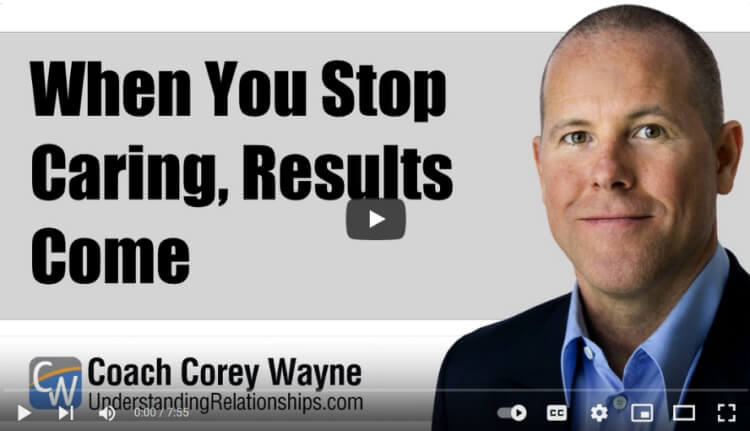
He creates content about dating, relationships, peak performance, and self-reliance.
Moreover, he is an authority in his space and among one of the top coaches the search engines suggest when you query for the keywords related to his practice. The video above is one of his best-performing videos, with nearly 2 million views. A lesson from this video regarding SEO is understanding your audience.
Corey touches on a massive pain point shared by his target market in this video – caring too much.
As a result, the YouTube algorithm pushed the content in front of a broader audience. SEO helps you get in front of your audience online. But you first have to know who they are, what they’re struggling with, and how you can help them.
Once these pieces are in place, attracting your market comes down to posting quality content on a consistent basis. And Corey understands this as he has posted over 5,000 videos on his YouTube channel.
Here are a few SEO best practices to implement so you can achieve similar results over time:
- Target the right keywords and keyword phrases related to your target market
- Use internal and external links within your website’s articles and blogs
- Optimize URLs, images, descriptions, and page titles
- Publish relevant, high-quality content consistently
- Increase the speed of your website’s load time
- Build up as many high-quality backlinks as possible
- Ensure your site is fast, efficient, and mobile-friendly
Social media marketing
Content marketing and social media marketing generally fall within the same bracket.
However, social media marketing is geared more toward satisfying the algorithms of the particular platform you plan on using rather than creating the content itself. For example, your social media marketing plan for Facebook will be different than your plan for LinkedIn because these platforms host different types of audiences.
LinkedIn is more professional and white-collared, while Facebook is more personal and casual. Because of this, you’d have to employ a different social media marketing strategy for each platform to accommodate their respective audiences.
Connie Jakab is a CEO, author, speaker, and coach who does this well.
Her content strategy takes into account the guidelines and audience types for each social media platform her brand is on. Her LinkedIn profile (and the content she posts there) is clean and professional. But when you view her Instagram, her content becomes more fun and entertaining.
This is by design.

Connie’s heartfelt Facebook post above exemplifies this perfectly. She uses empathy combined with her own opinion on what it means to belong to create a Facebook post that connects with her audience.
This post may be a bit too deep-rooted for the professionals on LinkedIn and a little too serious for younger crowds on Instagram. However, it’s the ideal post for Facebook when the audiences tend to be both older and more casual.
The key takeaway? Tailor your posts for the platform you occupy.
Here are a few tips to help you dial in your social media marketing:
- Choose the right platform: As a coach, you need to know which platform is best for you. This will come down to knowing your audience. If your target market is business executives, consider LinkedIn. On the other hand, if your market is young entrepreneurs, then you may be better off with Instagram or even TikTok.
- Determine your tone and brand voice: Is your tone professional and straightforward? Or is it cheeky and sarcastic? Again, this will be based on who your target market is.
- Publish content (consistently): Next, you need to create and publish content that resonates with your market. The key to success here is consistency. Social media marketing is not an overnight solution to get more coaching clients. It’s more of a crockpot than a microwave.
Email marketing
Here’s the deal: You have no control over social media. If those platforms make an algorithmic change tomorrow that hinders your ability to reach your audience, you won’t be able to do anything about it. If the change is drastic enough, it can be devastating to your business.
However, your email list is your personal property.
No algorithm change will compromise your ability to connect with your email list. Therefore, it is your most valuable asset when it comes to your coaching practice. It gives you power and autonomy as a coach. Ed Mylett is a speaker, coach, and leading performance expert who understands and executes this well.
He has an opt-in box on each page of his site, creating the opportunity for visitors to join “the world’s biggest movement and max out their lives.”
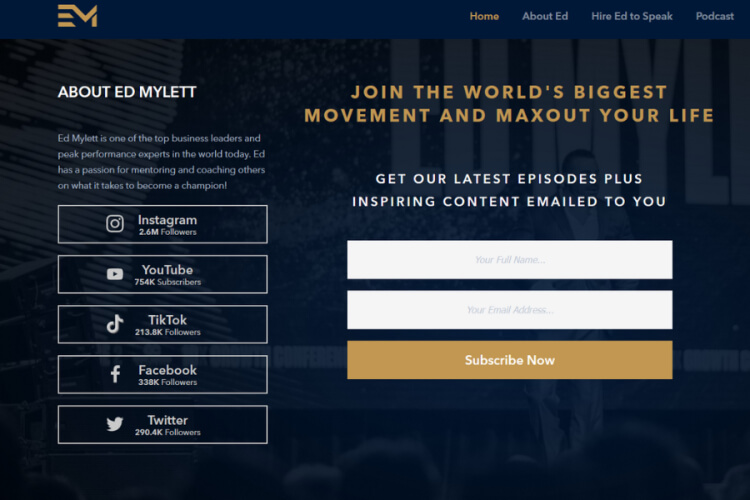
You can borrow Ed’s formula to build your own list.
All you need to do is keep two things in mind: one) you need to make it easy, and two) you need to make it valuable for people to opt in. You can make it easy by placing your opt-in form everywhere: all your web pages and articles by adding popup forms. And you can make it valuable by offering a freebie (ebook, cheat sheet, or manual) in exchange for visitors’ emails.
Here’s how you can start building your email list:
- Create an opt-in form on your site to collect email addresses and place it on every page
- Offer free value in exchange for their email (a mini course, a training, a webinar, etc.)
- Create content and have a CTA (Call to action) asking people to sign up for your list
- Promote your list as often as possible in your content
Your goal should be to get people off social media and onto your list. Remember, your email list is where you really build and nurture relationships with prospects to turn them into paying clients.
Building sales funnels
How does automating your revenue streams sound to you?
The closest form of passive income you can earn as a coach is building sales funnels. A high-ticket sales funnel automates and replicates the customer-buying process, taking prospects through various phases to eventually becoming clients. There are numerous phases that this sales funnel takes prospects through, which include:
- Awareness: This stage consists of attracting clients to your brand using workshops, summits, articles, videos, events, social media, etc. The goal here is to build awareness, establish a relationship, and build your email list with these leads.
- Interest: By this point, prospects have opted into your list. You can now use more targeted marketing efforts (newsletters, classes, courses, and emails) to continue to build their interest and establish the know, like, and trust factor.
- Consideration: At this stage, you’re continuing to build these relationships. You do this by using nurture sequences (targeted email campaigns) or free trials to build credibility.
- Purchase: This is where the prospects know, like, and trust you. Moreover, they feel your services can help solve their problems and, as a result, feel safe doing business with you.
Russell Brunson is an entrepreneur and marketing guru who specializes in helping businesses grow their traffic and revenue with sales funnels. He is the epitome of sales funnel success. His funnel has well over 100,000 subscribers.
As a result, he can sell his products and services at the click of a button and essentially print money on demand with no third party or overhead.
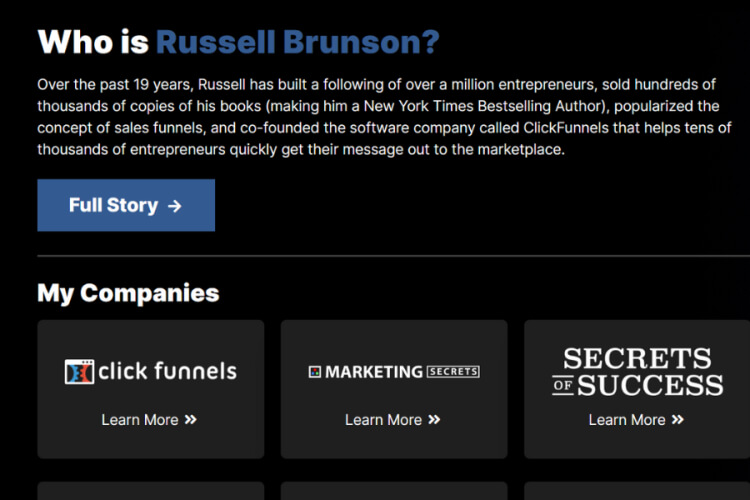
The important concept to understand with Russell is the necessity of an email list. You have an incredible asset in a thriving list. For this reason, it’s essential that you start building and nurturing immediately if you’re not already.
An email list gives you control and sovereignty over your business.
Partnerships
Partnerships can be excellent for building brand authority and credibility.
This is especially true if the partnership is with a prominent figure in your industry. This strategy was executed brilliantly when Dean Graziosi partnered with Tony Robbins for their Mastermind World Summit in 2021.
The event was a huge success. It was a three-day immersive conference for participants to evolve and scale their businesses. The event hosted numerous entrepreneurs who shared their valuable insights for business success, covering topics such as how to create an irresistible offer, mastering marketing principles, and scaling businesses for explosive growth.
Here are a few tactics to create similar partnerships in your own practice:
- Develop a plan, coaching package, or summit concept that adds value to others
- Connect with coaches in your industry whom you trust and respect
- Pitch your idea and be willing to compromise if their input is valid and contributes to the overall concept of your event/plan/coaching package
- Create a partnership agreement and register the partnership
- Layout the tax responsibilities and acquire the necessary permits or licenses
Virtual workshops
A virtual workshop consists of a single speaker working in a group setting with others.
Workshops focus on using a 30 to 90-minute timeframe to teach one specific outcome. This process is crucial as it prepares prospective clients to feel motivated to work with you because you helped them experience a quick win.
This is referred to as the quick workshop win formula.
At Entrepreneurs HQ, we focus on a single, solvable problem our market is facing. We then create an easy and fast solution to that problem, which we share in our virtual workshop.
Here is a testimonial from one of my workshop clients confirming the effectiveness of this strategy.
“From my first workshop, several people joined my group- and 1-on-1 coaching program. I intend to run one a month going forward, and I now use the workshops as my primary way of attracting clients!”
Janine Bolon, Podcaster & Author
This formula creates an intense desire in clients to capitalize on the momentum they’ve built with that small win.
What one small victory can you help your clients achieve quickly? And how can you distill the information that will help them achieve that win in a 30 to 90-minute virtual workshop?
Virtual summits
Another way you can get coaching clients is through a virtual summit.
If you’ve ever been to an expo, trade show, or conference, you’re familiar with the concept of a virtual summit. A virtual summit is a multi-day, multi-speaker event that uses the framework of a live, in-person event (such as a conference) and applies it to the digital world.
Virtual events can help you get coaching clients due to the abundance of networking opportunities that are available.
Since 2015, I have hosted more than 15 virtual summits.
And I have seen time and again that virtual summits can help maximize the subscribers, buyers, and clients for coaches. In fact, Sara Artesmisia, one of my previous coaching clients, credited a virtual summit I hosted as the catalyst that dramatically grew her email list and revenue.
Here’s what she had to say:
“Working with Liam allowed me to grow my email list by 5,000 people, generate $1,000s, and pivot to a completely new niche in just a few short weeks. It’s the best decision I’ve made yet. It was amazing! I’m still getting emails from people all over the world saying how much the summit has changed their lives. So awesome.”
– Sara Artemisia, Plant Spirit Wisdom Teacher & Coach
If you’re interested in hosting a virtual summit, I suggest getting help.
A lot goes on behind the scenes to launch these summits. Therefore, doing it on your own can be daunting. So, ensure that you ask for help the first time around to ensure that your event is the success it has the potential to be.
Podcasting
There are over 3 million podcasts in 2024.
This medium has exploded in popularity and, as a result, offers an excellent opportunity to draw in coaching clients. Now, there are two ways to go about this:
- Be a guest on other people’s podcasts
- Start your own podcast
Either is fine, but the former will usually yield quicker results than the latter. Since starting Entrepreneurs HQ in 2015, I have been featured on many podcasts. These guest visits have been invaluable in expanding my online presence and turning some of the audience into coaching clients.
Here are some best practices for pitching podcasts:
- Do your homework: Ensure you are familiar with the podcastor you’re pitching. Learn about their brand, their audience, and their podcasting style. And then tailor your pitch to align with their platform values.
- Value first: Always lead with value. How can your knowledge and expertise help the podcaster’s audience? Podcasters aren’t looking to bring on guests for the sake of having a warm body in the seat across from them. They want people who have real-world experience who can add value to their audience. Determine what you can give and lead with that in your pitch.
- Follow-up: Podcasters are busy. They have a million and one things on their plate. So, you may have to send a few polite follow-up emails to remain top of mind. However, you should cap your follow ups to three or four emails, with each one spread at least a week or two apart. If they haven’t gotten back to you by the forth email, they’re probably not interested. Don’t take it personally. Simply move on to the next one.
I’ve created a platform called Talks that helps you get featured on podcasts. Just create your speaker profile and get matched with speaking opportunities.
YouTube
Regardless of your coaching specialization, you’ll have potential clients on YouTube. A prominent life coach who has used this platform quite well is Robin Sharma. With almost one million subscribers, Sharma has been creating video content for more than 15 years.
And he follows a simple formula to engage prospective clients.
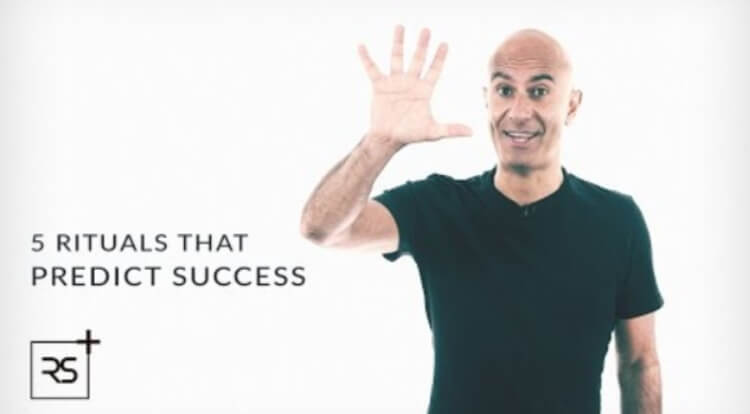
He knows his target market is success-conscious. They are entrepreneurs, business owners, and high-performance leaders looking to make an impact in the world. And the video above is a great example of Robin addressing his audience’s desire for success.
You can take advantage of this medium as well. Here are a few steps to get started:
- Define your niche
- Create an inventory of video ideas
- Set a content schedule
- Make attractive thumbnails
- Optimize for SEO
- Upload consistently
Building your online community
It’s important that online coaches see prospects and leads not just as potential clients but as a community.
You’re building a community of like-minded people. Think of it as a team that shares similar goals and values. And periodically, you converse in a business context. This mindset shift is essential if you want lasting relationships and consistent client work.
Master Coach and co-founder of Mindvalley (the number one transformational platform), Ajit Nawalkha, has done this exceedingly well.
His YouTube channel for Mindvalley offers a place for coaches, business owners, and entrepreneurs to gather. They discuss ideas, concepts and tactics, for their personal and professional development, allowing them to connect and grow as a singular unit.
That is the power of an online community. And here’s how you can start building your own:
- Research and understand your target audience
- Create relevant content that helps them solve their problems
- Stay consistent by continually publishing content for your audience
- Be responsive to those who interact with your content
Digital PR
Digital PR shares similarities with conventional PR.
However, it provides better opportunities to connect with people in a more targeted way. Moreover, digital PR uses digital marketing tactics, including SEO, lead generation, social media campaigns, and content and influencer marketing, to nurture relationships. Few coaches have done this better than Marie Forleo.
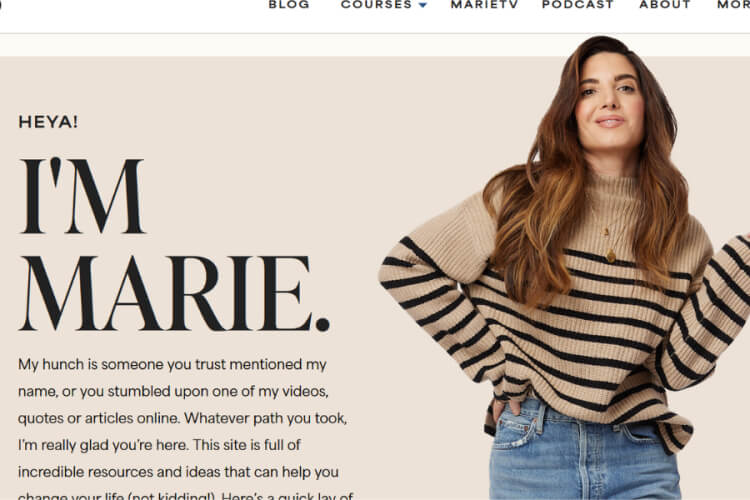
At nearly every touchpoint in her digital ecosystem (from her YouTube channel to her website), she has effectively used digital PR to spread her brand. As a result, her business is thriving spectacularly.
Her homepage mentions the many mediums she uses to spread her brand: videos, articles, quotes, and other resources. She also has courses, a podcast, and a weekly show called MarieTV.
The key takeaway with Marie regarding digital PR is diversification. The more platforms you occupy, the greater the chance of you connecting with a broader audience to attract more coaching clients.
Here are a few digital PR suggestions:
- Identify your target market
- Brainstorm and come up with content ideas
- Choose the platforms you’ll occupy
- Post regularly to nurture the relationships with your audience
- Build key relationships with thought leaders in your industry
- Measure results to see what needs to be improved
PPC ads
PPC or pay-per-click can be another effective strategy to attract coaching clients.
This form of marketing involves paying a fee whenever someone clicks on one of your ads. The best part? You only pay if your ad actually gets clicked. Therefore, this is an affordable method to advertise as a coach.
Here’s how you can get started:
- Determine where you want to advertise (Google, Instagram, or Facebook ads)
- Select the keywords for your bidding offer
- Choose a daily, weekly, or monthly budget
- Track your CTR (Click-through rate)
Mike McGregor is a Life Potential Coach who helps people become the Hero in their own lives. And he has used this strategy to great effect.
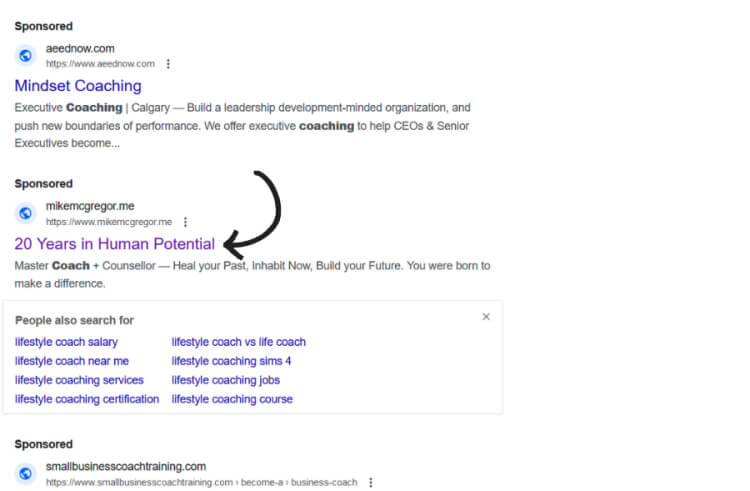
His PPC ad (shown above) targets the keywords “lifestyle coach”, “lifestyle coaching services”, and more. This setup creates a simple way for prospective clients to find Mike and his business through a simple Google search.
The important thing to learn from this example is understanding what your audience is looking for. This ad is successful because Mike knows his market. Period.
Paid social ads
Unlike organic posts, paid social ads are paid, sponsored advertisements on social media platforms. These types of ads can include Instagram and Facebook paid ads or even LinkedIn promotions.
Here’s how you can get started with paid social ads:
- Define the objectives for your coaching practice
- Familiarize yourself with your audience
- Study your competition
- Set the bar for success for your campaign
How to Get More Clients From Your Existing Coaching Clients
If you want more coaching clients, start with the ones you already have. These people are your foundation. Moreover, if you deliver results, your current clients can become the launchpad you spring from to skyrocket your practice.
So, here’s how to get more clients using your existing ones:
- Do good work: For obvious reasons, people won’t recommend subpar services to their friends, family, or associates. The first thing you need to do to land more coaching clients is to ensure you deliver exceptional results for your current clients. It all starts here.
- Form relationships: You need to do more than just “coach” your clients. You should form meaningful relationships with them. This comes from a desire to help them grow and a genuine concern for their success.
- Ask your clients: Once you’ve helped your clients create positive changes and formed meaningful relationships with them, you now need to ask for that testimonial or referral. You can also create case studies using client results from the past (with their permission, of course).
How to Monitor and Measure Your Marketing Efforts
Now, you need to monitor your marketing efforts. You can’t improve what you don’t track. So, it’s essential to understand what marketing KPIs to measure, what you need to look for, and when you should adjust your strategy. Here are a few simple tips that can help:
Choosing the right marketing KPIs
There are countless criteria to potentially focus on in your coaching business. With so many things vying for your attention, what’s the best use of your time? Well, it will be a little different for every coach, depending on their goals. However, in terms of client acquisition, here are a couple of metrics you should monitor:
CAC metrics
CAC, or Customer Acquisition Cost, tracks the cost of attracting new clients. It is done by combining and adding up sales and marketing costs during a specific timeframe and then dividing them by the number of new clients acquired during that time.
Here are some of the performance KPIs you need to know as a coach to monitor your CAC metrics:
- Number of visitors: This metric monitors the number of leads that funnel through to your site via your CAC efforts.
- Gross ad revenue: all revenue that is generated via the sales made through your advertising campaigns.
- Churn: Your churn rate represents the number of customers who stop using your services. It’s usually assessed for a certain time length: monthly, quarterly, or annually.
- Net profit and marketing costs: Net profit is the dollar amount that your coaching business generates after deductions: interests, taxes, operation costs, along with other expenses. And marketing costs represent the money paid for promotions, ads, PR, and more.
Client retention
Client retention represents your ability to retain clients and prevent them from wanting to switch to your competitors. Here are a few key metrics you should track to boost your customer retention rates:
- Customer churn rate: This metric is the percentage number of customers who cease doing business with you over a set time period.
- Customer satisfaction: The measurement of how well your products and services meet your client’s needs. It’s the quality of the customer experience.
- Customer lifetime value: CLV represents the total revenue your business can generate from a single client throughout the working relationship.
- Loyal customer rate: As the measurement of customer loyalty, the loyal customer rate informs you of how many clients you’ve retained over a specific amount of time.
Analyzing your marketing reports
Your marketing reports consist of collecting and analyzing your marketing metrics.
This process can help you make better marketing decisions in the future. Moreover, it may also reveal potential new strategies that may be more effective. This can result in better time, money, and resource allocation in your next marketing campaign.
When to adjust your marketing strategy based on data
If the data indicates you’re not generating your desired results, it may be time for a change. For example, if your social media ads are failing to attract the specific number of leads you set as your goal, this is evidence of a faulty strategy.
Maybe you need to learn more about your target market, make the copy more engaging, or shift some other aspect of your strategy.
Either way, some type of change must occur with your campaign to improve its performance.
Conclusion
A lot goes on behind the scenes to acquire coaching clients.
However, it can be done with enough persistence and the right strategy. And following this guide is a great first step in the right direction. At Entrepreneurs HQ, we are one of the largest online communities for entrepreneurs in the world, consisting of over 150,000 driven, success-oriented entrepreneurs. You can join our Facebook group here.
We’re here to help you reach your business goals. If you need additional assistance acquiring customers, watch our free training on how to get coaching clients.